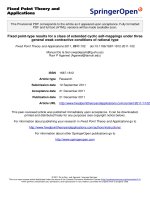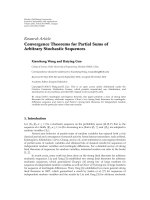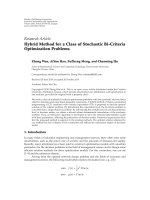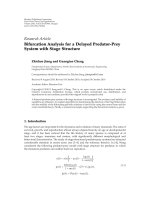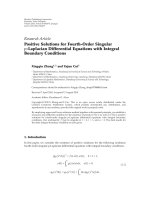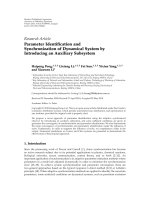Báo cáo sinh học: " Research Article Nodal Solutions for a Class of Fourth-Order Two-Point Boundary Value Problems" docx
Bạn đang xem bản rút gọn của tài liệu. Xem và tải ngay bản đầy đủ của tài liệu tại đây (499.21 KB, 11 trang )
Hindawi Publishing Corporation
Boundary Value Problems
Volume 2010, Article ID 570932, 8 pages
doi:10.1155/2010/570932
Research Article
Nodal Solutions for a Class of Fourth-Order
Two-Point Boundary Value Problems
Jia Xu
1, 2
and XiaoLing Han
1
1
Department of Mathematics, Northwest Normal University, Lanzhou 730070, China
2
College of Physical Education, Northwest Normal University, Lanzhou 730070, China
Correspondence should be addressed to Jia Xu,
Received 18 February 2010; Accepted 27 April 2010
Academic Editor: Irena Rach
˚
unkov
´
a
Copyright q 2010 J. Xu and X. Han. This is an open access article distributed under the Creative
Commons Attribution License, which permits unrestricted use, distribution, and reproduction in
any medium, provided the original work is properly cited.
We consider the fourth-order two-point boundary value problem u
Mu λhtfu,0<t<1,
u0u1u
0u
10, where λ ∈ R is a parameter, M ∈ −π
4
,π
4
/64 is given constant,
h ∈ C0, 1, 0, ∞ with ht
/
≡0 on any subinterval of 0, 1, f ∈ C
R, R satisfies fuu>0for
all u
/
0, and lim
u →−∞
fu/u 0, lim
u →∞
fu/u f
∞
, lim
u →0
fu/u f
0
for some f
∞
,f
0
∈
0, ∞. By using disconjugate operator theory and bifurcation techniques, we establish existence
and multiplicity results of nodal solutions for the above problem.
1. Introduction
The deformations of an elastic beam in equilibrium state with fixed both endpoints can be
described by the fourth-order ordinary differential equation boundary value problem
u
λh
t
f
u
, 0 <t<1,
u
0
u
1
u
0
u
1
0,
1.1
where f : R → R is continuous, λ ∈ R is a parameter. Since the problem 1.1 cannot
transform into a system of second-order equation, the treatment method of second-order
system does not apply to the problem 1.1. Thus, existing literature on the problem 1.1 is
limited. In 1984, Agarwal and chow 1 firstly investigated the existence of the solutions of the
problem 1.1 by contraction mapping and iterative methods, subsequently, Ma and Wu 2
and Yao 3, 4 studied the existence of positive solutions of this problem by the Krasnosel’skii
fixed point theorem on cones and Leray-Schauder fixed point theorem. Especially, when
2 Boundary Value Problems
ht ≡ 0, Korman 5 investigated the uniqueness of positive solutions of the problem 1.1
by techniques of bifurcation theory. However, the existence of sign-changing solution for this
problem have not been discussed.
In this paper, applying disconjugate operator theory and bifurcation techniques, we
consider the existence of nodal solution of more general the problem:
u
Mu λh
t
f
u
, 0 < t < 1,
u
0
u
1
u
0
u
1
0,
1.2
under the assumptions:
H1 λ ∈ R is a parameter, M ∈ −π
4
,π
4
/64 is given constant,
H2 h ∈ C0, 1, 0, ∞ with ht
/
≡0 on any subinterval of 0, 1,
H3 f ∈ CR, R satisfies fuu>0 for all u
/
0, and
lim
u →−∞
f
u
u
0, lim
u →∞
f
u
u
f
∞
, lim
u →0
f
u
u
f
0
1.3
for some f
∞
,f
0
∈ 0, ∞.
However, in order to use bifurcation technique to study the nodal solutions of the
problem 1.2, we firstly need to prove that the generalized eigenvalue problem
u
Mu μ
h
t
u, 0 <t<1,
u
0
u
1
u
0
u
1
0
1.4
where
h satisfies H2 has an infinite number of positive eigenvalues
μ
1
<μ
2
< ···<μ
k
<μ
k1
< ···, 1.5
and each eigenvalue corresponding an essential unique eigenfunction ψ
k
which has exactly
k −1 simple zeros in 0, 1 and is positive near 0. Fortunately, Elias 6 developed a theory on
the eigenvalue problem
Ly λ
h
t
y 0,
L
i
y
a
0,i∈
{
i
1
, ,i
k
}
,
L
j
y
b
0,j∈
j
1
, ,j
n−k
,
1.6
where
L
0
y ρ
0
y,
L
i
y ρ
i
L
i−1
y
,i 1, ,n,
Ly L
n
y,
1.7
Boundary Value Problems 3
and ρ
i
∈ C
n−i
a, b with ρ
i
> 0 i 0, 1, ,n on a, b. L
0
y, ,L
n−1
y are called the quasi-
derivatives of yt. To apply Elias’s theory, we have to prove that 1.4 can be rewritten to the
form of 1.6, that is, the linear operator
L
u
: u
Mu 1.8
has a factorization of the form
L
u
l
4
l
3
l
2
l
1
l
0
u
1.9
on 0, 1, where l
i
∈ C
4−i
0, 1 with l
i
> 0on0, 1,andu0u1u
0u
10ifand
only if
l
0
u
0
l
0
u
1
l
1
u
0
l
1
u
1
0. 1.10
This can be achieved under H1 by using disconjugacy theory in 7.
The rest of paper is arranged as follows: in Section 2, we state some disconjugacy
theory which can be used in this paper, and then show that H1 implies the equation
L
u
0 1.11
is disconjugacy on 0, 1, moreover, we establish some preliminary properties on the
eigenvalues and eigenfunctions of the generalized eigenvalue problem 1.4. Finally in
Section 3, we state and prove our main result.
Remark 1.1. For other results on the existence and multiplicity of positive solutions and
nodal solutions for boundary value problems of ordinary differential equations based on
bifurcation techniques, see Ma 8–12, An and Ma 13,Yang14 and their references.
2. Preliminary Results
Let
L
y
y
n
p
1
x
y
n−1
··· p
n
x
y 0
2.1
be nth-order linear differential equation whose coefficients p
k
·k 1, ,n are continuous
on an interval I.
Definition 2.1 see 7, Definition 0.2, page 2. Equation 2.1 is said to be disconjugate on an
interval I if no nontrivial solution has n zeros on I, multiple zeros being counted according
to their multiplicity.
4 Boundary Value Problems
Lemma 2.2 see 7, Theorem 0.7, page 3. Equation 2.1 is disconjugate on a compact interval I
if and only if there exists a basis of solutions y
0
, ,y
n−1
such that
W
k
: W
k
y
0
, ,y
k−1
y
0
··· y
k−1
.
.
.
.
.
.
y
k−1
0
··· y
k−1
k−1
> 0
k 1, ,n
2.2
on I. A disconjugate operator Lyy
n
p
1
xy
n−1
··· p
n
xy can be written as
L
y
≡ ρ
n
D
ρ
n−1
···D
ρ
1
D
ρ
0
y
···
,D≡
d
dx
, 2.3
where ρ
0
∈ C
n−k
Ik 0, 1, ,n and
ρ
0
1
W
1
,ρ
1
W
2
1
W
2
,ρ
k
W
2
k
W
k−1
·W
k1
,k 2, ,n− 1,
2.4
and ρ
0
ρ
1
···ρ
n
≡ 1.
Lemma 2.3 see 7, Theorem 0.13, page 9. Green’s function Gx, δ of the disconjugate Equation
2.3 and the two-point boundary value conditions
y
i
a
0,i 0, ,k− 1,
y
i
b
0,i 0, ,n− k −1
2.5
satisfies
−1
n−k
G
x, δ
> 0, ∀
x, δ
∈
a, b
×
a, b
. 2.6
Now using Lemmas 2.2 and 2.3, we will prove some preliminary results.
Theorem 2.4. Let (H1) hold. Then
i Lu0 is disconjugate on 0, 1, and Lu has a factorization
L
u
ρ
4
ρ
3
ρ
2
ρ
1
ρ
0
u
,
2.7
where ρ
k
∈ C
4−k
0, 1 with ρ
k
> 0 k 0, 1, 2, 3, 4.
ii u0u1u
0u
10 if and only if
L
0
u
0
L
1
u
0
L
0
u
1
L
1
u
1
0, 2.8
Boundary Value Problems 5
where
L
0
u ρ
0
u,
L
i
u ρ
i
L
i−1
u
,i 1, 2, 3, 4.
2.9
Proof. We divide the proof into three cases.
Case 1. M 0. The case is obvious.
Case 2. M ∈ −π
4
, 0.
In the case, take
u
0
t
e
−mt
,u
1
t
e
mt
,u
2
t
−sin m
t σ
,u
3
t
cos m
t σ
, 2.10
where m
4
√
−M, σ is a positive constant. Clearly, m ∈ 0,π and then
sin m
t σ
> 0,t∈
0, 1
. 2.11
It is easy to check t hat u
0
t, u
1
t, u
2
t, u
3
t form a basis of solutions of Lu0. By simple
computation, we have
W
1
e
−mt
, W
2
2m, W
3
4m
3
sin m
t σ
, W
4
8m
6
.
2.12
Clearly, W
k
> 0, k 1, 2, 3, 4 on 0, 1.
By Lemma 2.2, Lu0 is disconjugate on 0, 1,andLu has a factorization
u
Mu
2m
3
sin m
t σ
sin
2
m
t σ
m
e
mt
m sin m
t σ
1
2me
2mt
e
mt
u
,
2.13
and accordingly
L
0
u ρ
0
u e
mt
u,
L
1
u ρ
1
L
0
u
mu u
2me
mt
.
2.14
Using 2.14, we conclude that u0u1u
0u
10 is equivalent to 2.8.
Case 3. M ∈ 0,π
4
/64.
In the case, take
u
0
t
e
−mt
cos mt, u
1
t
e
−mt
sin mt, u
2
t
e
mt
cos mt, u
3
t
e
mt
sin mt,
2.15
where m
√
2/2
4
√
M.
6 Boundary Value Problems
It is easy to check that u
0
t, u
1
t, u
2
t, u
3
t form a basis of solutions of Lu0. By
simple computation, we have
W
1
cos mt
e
mt
, W
2
m
e
2mt
, W
3
4a
3
cos mt − sin mt
e
mt
, W
4
32m
6
.
2.16
From M ∈ 0,π
4
/64 and m
√
2/2
4
√
M, we have 0 <m<π/4, so W
k
> 0, k 1, 2, 3, 4
on 0, 1.
By Lemma 2.2, Lu0 is disconjugate on 0, 1,andLu has a factorization
u
Mu
8m
3
e
mt
cos mt − sin mt
×
⎛
⎝
cos mt − sin mt
2
2m
1
4me
2mt
cos mt
cos mt − sin mt
cos
2
mt
m
e
mt
cos mt
u
⎞
⎠
,
2.17
and accordingly
L
0
u ρ
0
u
e
mt
cos mt
u,
L
1
u ρ
1
L
0
u
e
mt
cos mt sin mt
u
e
mt
cos mt
m
u
.
2.18
Using 2.18, we conclude that u0u1u
0u
10 is equivalent to 2.8.
This completes the proof of the theorem.
Theorem 2.5. Let (H1) hold and
h satisfy (H2). Then
i Equation 1.4 has an infinite number of positive eigenvalues
μ
1
<μ
2
< ···<μ
k
<μ
k1
< ···. 2.19
ii μ
k
→∞as k →∞.
iii To each eigenvalue there corresponding an essential unique eigenfunction ψ
k
which has
exactly k − 1 simple zeros in 0, 1 and is positive near 0.
iv Given an arbitrary subinterval of 0, 1, then an eigenfunction which belongs to a
sufficiently large eigenvalue change its sign in that subinterval.
v For each k ∈ N, the algebraic multiplicity of μ
k
is 1.
Proof. i–iv are immediate consequences of Elias 6, Theorems 1–5 and Theorem 2.4.we
only prove v.
Boundary Value Problems 7
Let
Lu : u
Mu, u ∈ D
L
2.20
with
D
L
:
u ∈ C
4
0, 1
| u
0
u
1
u
0
u
1
0
. 2.21
To show v, it is enough to prove
ker
L − μ
k
h
·
2
ker
L − μ
k
h
·
.
2.22
Clearly
ker
L − μ
k
h
·
2
⊇ ker
L − μ
k
h
·
.
2.23
Suppose on the contrary that the algebraic multiplicity of μ
k
is greater than 1. Then
there exists u ∈ ker
L − μ
k
h·
2
\ ker
L − μ
k
h·, and subsequently
Lu − μ
k
h
x
u qψ
k
2.24
for some q
/
0. Multiplying both sides of 2.24 by ψ
k
x and integrating from 0 to 1, we
deduce that
0 q
1
0
ψ
k
x
2
dx, 2.25
which is a contradiction!
Theorem 2.6 Maximum principle. Let (H1) hold. Let e ∈ C0, 1 with e ≥ 0 on 0, 1 and e
/
≡0
in 0, 1.Ifu ∈ C
4
0, 1 satisfies
u
Mu e
t
,
u
0
u
1
u
0
u
1
0.
2.26
Then u>0 on 0, 1.
Proof. When M ∈ −π
4
,π
4
/64, the homogeneous problem
u
Mu 0,
u
0
u
1
u
0
u
1
0
2.27
8 Boundary Value Problems
has only trivial solution. So the boundary value problem 2.26 has a unique solution which
may be represented in the form
u
t
1
0
G
t, s
e
s
ds, 2.28
where Gt, s is Green’s function.
By Theorem 2.4 and Lemma 2.3 take n 4,k 2, we have
−1
4−2
G
t, s
> 0, ∀
t, s
∈
0, 1
×
0, 1
,
2.29
that is, Gt, s > 0, for all t, s ∈ 0, 1 × 0, 1.
Using 2.28, when e ≥ 0on0, 1 with e
/
≡0in0, 1, then u>0on0, 1.
3. Statement of the Results
Theorem 3.1. Let (H1), (H2), and (H3) hold. Assume that for some k ∈ N,
λ>
μ
k
f
0
.
3.1
Then there are at least 2k − 1 nontrivial solutions of the problem 1.2. In fact, there exist solutions
w
1
, ,w
k
, such that for 1 ≤ j ≤ k, w
j
has exactly j − 1 simple zeros on the open interval 0, 1 and
w
j
0 < 0 and there exist solutions z
2
, ,z
k
, such that for 2 ≤ j ≤ k, z
j
has exactly j − 1 simple
zeros on the open interval 0, 1 and z
j
0 > 0.
Let Y C0, 1 with the norm u
∞
max
t∈0,1
|ut|. Let
E
u ∈ C
2
0, 1
| u
0
u
1
u
0
u
1
0
3.2
with the norm u
E
max{u
∞
, u
∞
, u
∞
}. Then
L
−1
: Y → E is completely continuous, here
L is given as in 2.20.
Let ζ, ξ ∈ CR, R be such that
f
u
f
0
u ζ
u
,f
u
f
∞
u
ξ
u
, 3.3
here u
max{u, 0}. Clearly
lim
|
u
|
→0
ζ
u
u
0, lim
|
u
|
→∞
ξ
u
u
0.
3.4
Let
ξ
u
max
0≤
|
s
|
≤u
|
ξ
s
|
,
3.5
Boundary Value Problems 9
then
ξ is nondecreasing and
lim
u →∞
ξ
u
u
0.
3.6
Let us consider
Lu λh
x
f
0
u λh
x
ζ
u
3.7
as a bifurcation problem from the trivial solution u ≡ 0.
Equation 3.7 can be converted to the equivalent equation
u
x
λ
L
−1
h
·
f
0
u
·
x
λ
L
−1
h
·
ζ
u
·
x
.
3.8
Further we note that
L
−1
h·ζu·
E
ou
E
for u near 0 in E.
In what follows, we use the terminology of Rabinowitz [15].
Let E R × E under the product topology. Let S
k
denote the set of function in E which
have exactly k − 1 interior nodal (i.e., nondegenerate) zeros in 0, 1 and are positive near t 0,
set S
−
k
−S
k
, and S
k
S
k
∪ S
−
k
. They are disjoint and open in E. Finally, let Φ
±
k
R × S
±
k
and
Φ
k
R × S
k
.
The results of Rabinowitz [13]for3.8 can be stated as follows: for each integer k ≥ 1, ν
{, −}, there exists a continuum C
ν
k
⊆ Φ
ν
k
of solutions of 3.8, joining μ
k
/f
0
, 0 to infinity in Φ
ν
k
.
Moreover, C
ν
k
\ μ
k
/f
0
, 0 ⊂ Φ
ν
k
.
Notice that we have used the fact that if u is a nontrivial solution of 3.7, then all zeros of u
on 0, 1 are simply under (H1), (H2), and (H3).
In fact, 3.7 can be rewritten to
Lu λ
h
t
u,
3.9
where
h
t
⎧
⎪
⎨
⎪
⎩
h
t
f
u
t
u
t
,u
t
/
0,
h
t
f
0
,u
t
0,
3.10
clearly
ht satisfies (H2). So Theorem 2.5(iii) yields that all zeros of u on 0, 1 are simple.
Proof of Theorem 3.1. We only need to show that
C
−
j
∩
{
λ × E
}
/
∅,j 1, 2, ,k,
C
j
∩
{
λ × E
}
/
∅,j 2, ,k.
3.11
10 Boundary Value Problems
Suppose on the contrary that
C
ι
i
∩
{
λ × E
}
∅, for some
i, ι
∈ Γ, 3.12
where
Γ :
j, ν
| j ∈
{
2, ,k
}
as ν ,j∈
{
1, 2, ,k
}
as ν −
. 3.13
Since C
ι
i
joins η
i
/f
0
, 0 to infinity in Φ
ν
i
and λ, u0, 0 is the unique solutions of 3.7
λ0
in
E, there exists a sequence {χ
m
,u
m
}⊂C
ι
i
such that χ
m
∈ 0,λ and u
m
E
→∞as m →∞.
We may assume that χ
m
→ χ ∈ 0,λ as m →∞.Letv
m
u
m
/u
m
E
,m≥ 1. From the fact
Lu
m
x
χ
m
h
x
f
∞
u
m
x
χ
m
h
x
ξ
u
m
x
, 3.14
we have that
v
m
x
χ
m
L
−1
h
·
f
∞
v
m
x
χ
m
L
−1
h
·
ξ
u
m
x
u
m
E
x
. 3.15
Furthermore, since
L
−1
|
E
: E → E is completely continuous, we may assume that there exist
v ∈ E with v
E
1 such that v
m
− v
E
→ 0asm →∞.
Since
|
ξ
u
m
|
u
E
≤
ξ
u
m
∞
u
E
≤
ξ
u
m
E
u
E
,
3.16
we have from 3.15 and 3.6 that
v
χ
L
−1
h
·
f
∞
v
,
3.17
that is,
v
Mv χh
x
f
∞
v
,
v
0
v
1
v
0
v
1
0.
3.18
By H2, H3,and3.17 and the fact that v
E
1, we conclude that χhxf
∞
v
/
≡0, and
consequently
χ>0,v
/
≡0. 3.19
By Theorem 2.6, we know that vx > 0in0, 1. This means
χf
∞
is the first eigenvalue of
Lu ηhtu and v is the corresponding eigenfunction. Hence v ∈ S
1
. Since S
1
is open and
v
m
− v
E
→ 0, we have that v
m
∈ S
1
for m large. But this contradict the assumption that
χ
m
,v
m
∈ C
ι
i
and i, ι ∈ Γ,so3.12 is wrong, which completes the proof.
Boundary Value Problems 11
Acknowledgments
This work is supported by the NSFC no. 10671158, the Spring-sun program no. Z2004-
1-62033, SRFDP no. 20060736001, the SRF for ROCS, SEM 2006311, NWNU-KJCXGC-
SK0303-23, and NWNU-KJCXGC-03-69.
References
1 R. P. Agarwal and Y. M. Chow, “Iterative methods for a fourth order boundary value problem,” Journal
of Computational and Applied Mathematics, vol. 10, no. 2, pp. 203–217, 1984.
2 R. Ma and H. P. Wu, “Positive solutions of a fourth-order two-point boundary value problem,” Acta
Mathematica Scientia A, vol. 22, no. 2, pp. 244–249, 2002.
3 Q. Yao, “Positive solutions for eigenvalue problems of fourth-order elastic beam equations,” Applied
Mathematics Letters, vol. 17, no. 2, pp. 237–243, 2004.
4 Q. Yao, “Solvability of an elastic beam equation with Caratheodory function,” Mathematica Applicata,
vol. 17, no. 3, pp. 389–392, 2004 Chinese.
5 P. Korman, “Uniqueness and exact multiplicity of solutions for a class of fourth-order semilinear
problems,” Proceedings of the Royal Society of Edinburgh A, vol. 134, no. 1, pp. 179–190, 2004.
6 U. Elias, “Eigenvalue problems for the equations Ly λpxy 0,” Journal of Differential Equations,
vol. 29, no. 1, pp. 28–57, 1978.
7 U. Elias, Oscillation Theory of Two-Term Differential Equations, vol. 396 of Mathematics and Its Applications,
Kluwer Academic Publishers, Dordrecht, The Netherlands, 1997.
8 R. Ma, “Existence of positive solutions of a fourth-order boundary value problem,” Applied
Mathematics and Computation, vol. 168, no. 2, pp. 1219–1231, 2005.
9 R. Ma, “Nodal solutions for a fourth-order two-point boundary value problem,” Journal of
Mathematical Analysis and Applications, vol. 314, no. 1, pp. 254–265, 2006.
10 R. Ma, “Nodal solutions of boundary value problems of fourth-order ordinary differential equations,”
Journal of Mathematical Analysis and Applications, vol. 319, no. 2, pp. 424–434, 2006.
11 R. Ma and J. Xu, “Bifurcation from interval and positive solutions of a nonlinear fourth-order
boundary value problem,” Nonlinear Analysis: Theory, Methods & Applications, vol. 72, no. 1, pp. 113–
122, 2010.
12
R. Ma and H. Wang, “On the existence of positive solutions of fourth-order ordinary differential
equations,” Applicable Analysis, vol. 59, no. 1–4, pp. 225–231, 1995.
13 Y. An and R. Ma, “Global behavior of the components for the second order m-point boundary value
problems,” Boundary Value Problems, vol. 2008, Article ID 254593, 10 pages, 2008.
14 Z. Yang, “Existence and uniqueness of positive solutions for higher order boundary value problem,”
Computers & Mathematics with Applications, vol. 54, no. 2, pp. 220–228, 2007.
15 P. H. Rabinowitz, “Some global results for nonlinear eigenvalue problems,” Journal of Functional
Analysis, vol. 7, no. 3, pp. 487–513, 1971.
